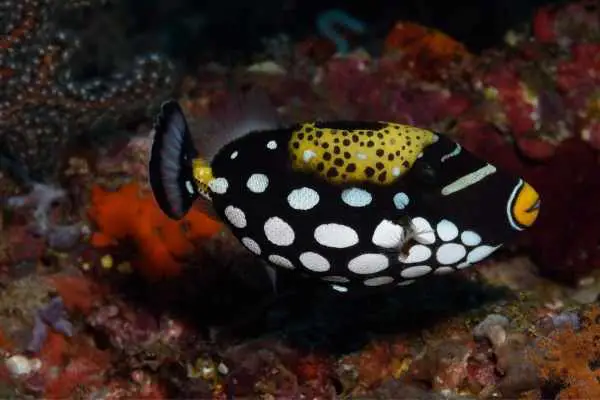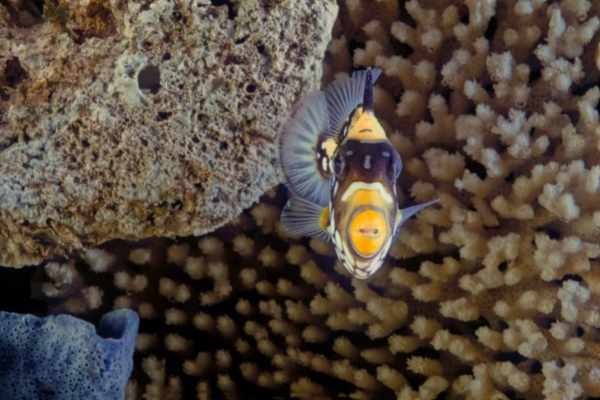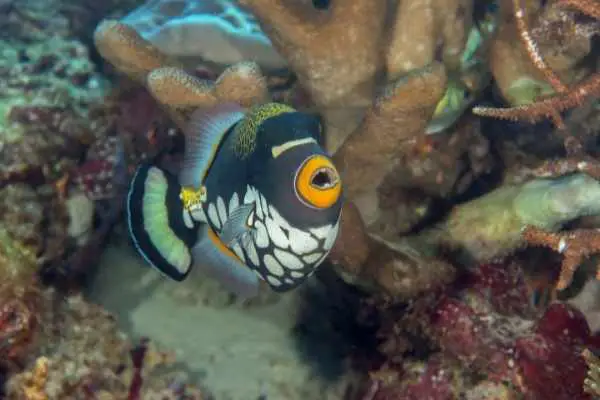The clown triggerfish (Balistoides conspicillum) get their name from two different sources: that vibrant appearance and the bubbly personality they bring to a saltwater aquarium. Plenty of hobbyists yearn to add one of these curious triggers to their collection. And while you couldn’t ask for a more engaging fish, you need to do some homework. Because that “clown” side? Yeah, it comes with a horrible streak. (We’re talking horror movie clown level here)
Table of Contents: Clown Triggerfish Care
Now, before you run screaming from the big top, clown triggerfish aren’t THAT scary. Well, not if you know what you’re getting yourself into. But that’s why you’re here, right? To learn everything you need to care for these colorful members of the trigger group. And these links will help you avoid your worst nightmares.
- Quick Facts
- Description of the Clown Triggerfish
- Clown Triggerfish Lifespan
- Creating the Ideal Clown Trigger World
- Clown Triggerfish Diet
- Clown Triggerfish Behavior and Tank Mates
- Breeding the Clown Triggerfish
- Pros and Cons
- For More Information

Quick Facts
- Common Names: Clown triggerfish, Clown trigger, Baliste clown, Big-spotted triggerfish, Big white-spotted triggerfish
- Scientific Names: Balistoides conspicillum
- Size: Up to 19 inches (48.2cm)
- Minimum Tank Size: 120 Gallons (454L)
- Reef Safe? No
- Care or Experience Level: Easy-Moderate
- Preferred Diet: Carnivore
- Original Part of the World: Indo-Pacific, Western Atlantic
Description of the Clown Triggerfish
Aquarists and divers alike love clown triggerfish for the same reason: they’re striking in appearance. You can’t miss them! Against a base of black scales, you get random splotches of white. Then there’s a brief touch of yellow around the mouth and under the dorsal fin. The patterns put people in mind of leopards, tribal tattoos, and (you got it) clowns. And no two fish look quite the same. They stand out wherever you happen to see them.
Even juvenile clown triggerfish get in on the color game. You see more yellow and less of those white spots when the fish are youngsters. As they grow, the yellow shrinks away. And then the white breaks apart into the characteristic patterns everyone loves. It’s an easy way to tell an immature fish apart from an adult.
The bold pattern serves a critical function out on the reefs. Similar to the vibrant shades of a poison dart frog, it’s a blatant warning to any fish that might eye the trigger as a source of food. Now, clown triggerfish aren’t poisonous. But their attitude IS. These aggressive fish patrol their territories with a ferocious set of eight teeth. And if any fish intrude across the borders? They’re sure to get a nasty bite. Those bright patterns warn other clowns and potential predators they’re asking for trouble.
As with other triggers, clown triggerfish sport three spines within their dorsal fin and another under the abdomen. Those spines work to defend the fish against any predator NOT impressed by the color display. And they also lock the trigger into caves and crevices. It’s a way to hide out safely. Once the spines wedge in place, NOTHING can remove the fish until they release. And any predator that bites down on a spine? They’re not going to enjoy the meal.

Clown Triggerfish Lifespan
Clown triggerfish have a WIDE distribution. You can spot them on reefs throughout the Indo-Pacific range, around the coast of South Africa, and throughout the western Atlantic. They haunt the drop-offs on the outer edges of coral reefs, venturing out to swim in the open. (After all, what are they worried about?)
Unfortunately, climate change and sedimentation of coastal regions are starting to impact the triggerfish’s range. Their numbers are declining. It’s a pattern showing up in plenty of other reef species.
Due to those unique patterns, it’s easy to recognize specific clown triggerfish out in the wild. Researchers estimate a lifespan of around eight years (minus environmental impact, of course). However, hobbyists who dial in on their tank maintenance quality have seen triggers survive for up to 20 years.
Creating the Ideal Clown Trigger World
As you might guess – with their penchant for reefs – clown triggerfish prefer the tropical life. They hang out around Australia, the Mariana Islands, Micronesia, New Caledonia, and Samoa (in the Indo-Pacific). As you round South Africa and enter the Atlantic, they thrive in the warm currents around Florida, the Caribbean, and into the Gulf of Mexico.
Steep drop-offs don’t phase these triggers. And divers encounter them out in the open, away from the protective cover offered by the reef. (During the day, anyway) At night, triggerfish need a crevice to call a “bed.” Juveniles stay in shallower waters (not much deeper than 70 feet/20m). They need time to grow into their belligerent attitudes. So they hug regions near caves and overhangs.
And those two features sum up the needs of the clown triggerfish: room to swim and somewhere to hide. You want open space to allow your trigger to spread its fins. (Not to mention accommodate their awkward swimming ability) But you also want to add plenty of live rock for them to return to at night. There should be caves or crevices large enough for the fish to wedge inside and stay “locked” in place.
You also need to ensure plenty of strength in your rock structures. Clown triggers like rearranging the décor. And that means knocking over rocks or coral (we’ll address that in a second), uprooting decorations, and shoving ANYTHING out of the way. If you don’t want to risk injury to their tank mates, you need to secure everything. This species also isn’t a good choice for bare tank bottoms – unless you want to risk cracking the glass.

Clown Triggerfish Tank Size
When you hit your favorite fish store (or cruise the online stores), you’ll probably see juvenile clown triggerfish for sale. They look attractive, and they only come in around 2 inches (5cm). You can get away with a tank of 120 gallons (454L) at that point. Yes, it sounds excessive for a (relatively) small fish. But these triggers GROW. And in no time, you’ll find yourself needing to upgrade if you don’t make adequate plans.
Realistically, to provide enough swimming space, you’ll probably want to consider going with 200 gallons (757L) for your clown trigger. This will suffice when the fish hits the adult size of 19 inches (48.2cm). And you may want to think even BIGGER than that. Clown triggers are MEAN. Adding space will help diffuse some of that misbehavior. Going smaller will emphasize their aggression.
You should also opt for a glass tank over acrylic. Clown triggers have SHARP teeth that sit in the front of their mouth. A little like a curious dog, they explore the world with those teeth. This often leads to scratches in acrylic. Some hobbyists have even found scrapes in their GLASS! It’s another argument for going as large as possible with your tank (not to mention keeping your clown triggerfish entertained).
Along those same lines, you want to keep all of the wires, filters, and pumps OUT of reach of your trigger’s exploring teeth. You don’t want to notice changes in your water conditions and then find out your fish chewed through an exposed cord in the tank.
Are Clown Triggerfish Reef-Safe?
Clown triggerfish live on coral reefs. So that must mean they’re perfect for reef tanks, right? WRONG! While these triggers don’t actively target corals as part of their diet, their destructive nature in an aquarium makes them a poor choice.
They rearrange EVERYTHING, and that can include your favorite corals. Even if they don’t bother the LPS or SPS corals in the tank, they can knock a rock onto the coral and damage the polyps.
You also can’t risk keeping other invertebrates around clown triggerfish. You often find crustaceans and mollusks on their diet, and they’ll happily devour the shrimp and crabs you added to the tank. Clams, in particular, end up serving as a “dental chew” for triggers. As such, you’re better off keeping them in fish-only displays.

Clown Triggerfish Diet
Clown triggerfish won’t pose much trouble for you in the diet department. They’re healthy carnivores. And as long as you provide a variety of protein options, they’ll eat without a problem. It makes this part of their care easy to handle.
In the wild, clown triggers feed on crustaceans, mollusks, sea urchins, and tunicates. They spit water into the sand to flip sea urchins over. Then they can go after the urchin without fighting all of those spines. The same “spitting” technique also helps them uncover crabs and shrimp that might try to hide out in the sand.
You don’t need to figure out how to source sea urchins, though. As long as you’re providing high-quality (and variety), they’ll accept any of these foods:
- Clams
- Krill
- Shrimp
- Silversides
The most significant part of the diet that matters for clown triggerfish is their teeth. Those eight prominent “fangs” grow continuously. And if they can’t grind them down with hard foods (such as clams on the half shell), the teeth will overgrow and cause mouth pain. If the teeth get out of control, the fish may not be able to eat.
If you DON’T provide foods that allow your trigger to grind their teeth naturally, you’ll need to have the teeth ground manually. This involves capturing the fish (watch the spines) and a Dremel tool.
Now, imagine someone holding you down and using a Dremel on YOUR teeth (minus the fact that your teeth have a central nerve and blood supply). Sound stressful? (Sound like a plot for a clown horror movie?) Yeah, it’s stressful for a clown triggerfish, too. MUCH better to pick up some clams instead.
Clown Triggerfish Behavior and Tank Mates
You won’t see more than one clown triggerfish in a territory. They’re NOT social. They don’t even hang out in pairs. That aggressive reputation isn’t unique to the home aquarium. As such, you can’t keep more than one in a tank together. You WILL end up with a clown fight ring. (It’s not pretty or funny)
The older and larger this trigger species gets, the nastier its reputation. And since those eight teeth are strong enough to grab a rock and STAY there? Yeah, they’ve earned the right to use those patterns as a warning.
Juvenile clown triggerfish are more on the timid side. Until they reach around 8 inches (20cm), they tend to hide. You don’t see them out in the open quite as much. That fearless behavior doesn’t come in until they grow up. This is why it’s ideal to buy a clown trigger while it’s young and small. Then it can grow up with tank mates. (No guarantee it WON’T bully them down the road, but it should help)
Clown triggers possess a natural curiosity. Pair that with “constant” hunger, and they’re easy to train. Plenty of aquarists compare them to pet dogs. Some people even teach them to accept food directly from their hands. You can see some of this trainability in the YouTube video below:
Once clowns reach their adult size, they shed that reclusive habit and turn into predators. Any small, peaceful, or slow tank mates? Yeah, now they’re potential snacks. And, of course, invertebrates go straight on the menu. You don’t want to run the risk and keep any of those groups in the tank – even if the juvenile clown triggerfish tolerated them.
You also need to avoid a few groups you might not traditionally think of as “victims.” While not small, peaceful, or necessarily slow, these fish often find themselves getting chewed on by clown triggers:
- Eels
- Lionfish
- Sharks
That doesn’t mean you’re stuck with a one-fish display tank, though. Clown triggerfish don’t seem to mind sharing space with other “big meanies.” And since they have that colorful pattern, they look stunning with these groups:
- Angelfish
- Bass
- Groupers
- Pufferfish
- Tangs
- Wrasses
And if you want to choose another species of triggerfish? You’re in the clear there. It’s only members of their species they have problems with.

Breeding Clown Triggerfish
Clown triggerfish look the same, whether males or females. Attempting to tell one apart from the other is next to impossible. Of course, trying to breed them in captivity (for the hobbyist, anyway) is also next to impossible. Since you can’t keep more than one in the home aquarium, you’re not going to see baby clown triggers any time soon. It requires a commercial setup to contemplate.
Clown triggers build nests. Males show up at designated spawning areas and choose their territory. Those teeth come in handy to drive off any other males that might want that spot in the sand. When the females arrive, males put on a display to attract one. A female will choose a male and lay her eggs in his nest. He then fertilizes the eggs, and the pair guard the nest against potential predators.
It takes around eight days for the eggs to hatch. During that time, the female will blow water over the eggs to provide proper oxygenation. And the male keeps up patrol around the territory. Once the eggs hatch, the female may visit another male and start the process over again. Or she may leave, calling a halt to the spawning season.
Pros and Cons
The astonishing patterns of the clown triggerfish – to say nothing of their size and personality – attract people’s attention. They’re not the easiest fish in the world to manage, though. And if you’re hesitating over that “Buy Now” button, make sure you weigh the pros and cons first.
Pros
- Clown triggerfish can adjust the brightness of their colors from day to day, denoting their mood and health.
- Courtesy of a natural curiosity – and a high food drive – it’s easy to train clown triggers.
- Young clown triggerfish recover quickly from shipping, and they remain calm and tolerant of their tank mates, extending the amount of harmony in the tank.
Cons
- Clown triggerfish are ALWAYS hungry, and they may attempt to bite your hand or arm when you work in the tank.
- Without a proper diet with hard foods – such as clams – clown trigger teeth can overgrow.
- Clown triggerfish grow more aggressive with age and size, and they often turn on their smaller and more peaceful tank mates.
For More Information
It only takes one glimpse of a clown triggerfish to catch your attention. Of course, once you see them take down your favorite hermit crab, you might think twice. But that’s why you have this extra information to ensure you have all of the facts – before you cute little clown goes psycho.
This YouTube video addresses all of the facts you need about the clown triggerfish:
Want to know about some of the best clown triggerfish tank mates?
Or maybe you’d like to consider another triggerfish (since two clowns DON’T mix):
Conclusions
Even if you HATE clowns, you’ll probably love the clown triggerfish. And once you overlook the fact they have eight savage teeth and want to eat – well, almost anything – you’ll see they’re not like clowns (not really). They look stunning, and that trainability makes them a joy to come home to every day. Just watch your fingers in the tank. And no tapping on the glass.
References
- Fenner, B. “A Cruiser and a Bruiser, The Clown Trigger, Balistoides conspicillum.” Wet Web Media.
- Froese, R. and Pauly, D. 2005. “Balistoides conspicillum.” FishBase.
- Michael, S.W. 2001. Marine Fishes: 500+ Essential to Know Aquarium Species.


Leave a Reply